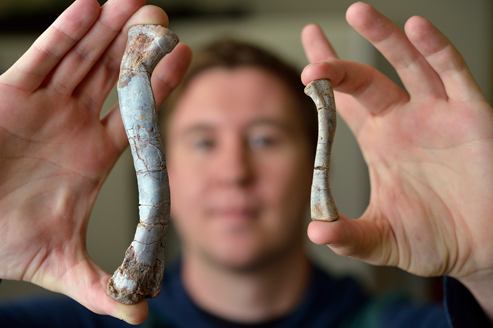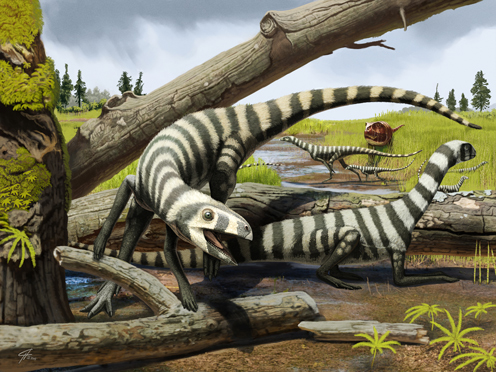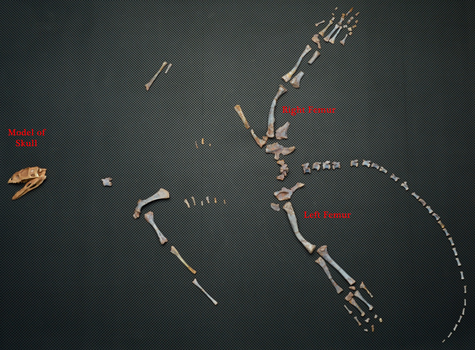Triassic Fossil Study Suggests Fossil Size a Poor Predictor of Maturity in Ancient Reptiles
Scientists at the Department of Geosciences at Virginia Tech (Blacksburg, Virginia, USA), have published a paper in the “Journal of Vertebrate Palaeontology”, that challenges some of the long-held assumptions about the growth of ancient reptiles. Using an analysis of muscle tissue scars preserved on limb bones of Triassic fossils combined with cross-sectional bone studies to examine growth and the age of individuals, the researchers conclude that dinosaurs and their close relatives within the Archosauria had much more variation in growth patterns than expected. The growth variation does not seem to be linked to gender.
Triassic Fossils
Size of the Fossil Bone May Not be Directly Linked to the Maturity of the Animal
Picture credit: Virginia Tech
Lead author of the scientific paper Christopher Griffin is pictured above holding two differently sized leg bones (femora) of Asilisaurus kongwe the study suggests that bone size is not a good indicator of animal maturity.
Asilisaurus kongwe – On the Road to the Dinosaurs
Fossils of the silesaurid Asilisaurus kongwe were used in the study. Sufficient fossil material had been excavated over the course of nearly ten years of field trips to the Middle Triassic sediments of Tanzania to provide a suitable sample set and this little carnivore was, most likely an ancestor of the Dinosauria. It has been assigned to the Dinosauriforms, a clade of archosaurs that gave rise to the dinosaurs and the birds.
The researchers found that when they examined the large number of bones associated with this species, they found that mature, adult bone size did not uniformly split into two distinct groups (male and female). Instead, they found much more variation in bone size. It might be difficult to apply this research to the whole of the Dinosauria, but as co-author Professor Sterling Nesbitt states:
“The earliest dinosaurs grew just like their closest relatives, and there are very few features that make dinosaurs unique from their closest relatives.”
If this is the case, then the Asilisaurus study could shed light on the growth habits (ontogeny), of the dinosaurs, at least the first types of dinosaur that evolved a few million years after Asilisaurus roamed Africa.
An Illustration of Asilisaurus kongwe
Picture credit: Andrey Atuchin
The large sample size (most silesaurids and early dinosaurs for that matter are known from highly fragmentary fossil material), permitted the scientists to study several individual specimens that appeared to be more mature than larger specimens and individuals of the same approximate size that appeared to be a different stages of growth.
Analysis of Muscle Scars
Analysis of the scars found on the surface of the bones where tendons and muscles once attached and cross-sectional studies showing the internal structure of the bone itself, allowed the scientists to plot changes in the anatomy and bone tissue. The researchers found that although the sample set lived roughly at the same time and in the same location, they grew differently from each other.
Think of the analogy of a modern family with siblings and cousins of different heights and weights.
The more mature an individual was at death, the larger its bone scars appeared. As with any animal or person, an individual skeleton goes from possessing few scars to possessing many during life, with scars appearing in a particular order as the age of the individual increases.
Size is Probably a Poor Predictor of Skeletal Maturity in Silesaurids
The researchers conclude that except for the smallest and largest individuals in the study (the least and most mature respectively), size of bones is probably a poor predictor of skeletal maturity in Asilisaurus and therefore, probably in other silesaurids and ultimately the early members of the Dinosauria as well.
Commenting on the implications for this research, Master’s student Christopher Griffin explained:
“Our study includes more individuals and more bone scars and with this increase in sample size we found that individuals fall on a trajectory that is more similar to maturity difference. This suggests that similar variation in bone scars in early dinosaurs is variation in growth not male and female difference. Because this variation appears to be widespread among early dinosaurs and their closest relatives, it is likely that high variation in growth between individuals characterised the most recent common ancestor of Asilisaurus and all dinosaurs.”
Articulating the Fossils of an Individual (Asilisaurus kongwe)
Picture credit: Virginia Tech with additional annotation by Everything Dinosaur (note the skull to the left of the picture is a model)
Growth Rates Not Well Understood
The growth rates of early, rapidly diverging ancestral dinosaurs is very poorly understood. This study that assessed the thigh bones (femora) of Asilisaurus kongwe provides an opportunity to examine in detail the ontogeny of one of the closest known relatives of the Dinosauria.
Everything Dinosaur has written about the discovery of Asilisaurus, to read the article: Dinosaurs Around Ten Million Years Earlier than Previously Thought
Everything Dinosaur recognises the help of Virginia Tech in the compilation of this article.









Leave A Comment